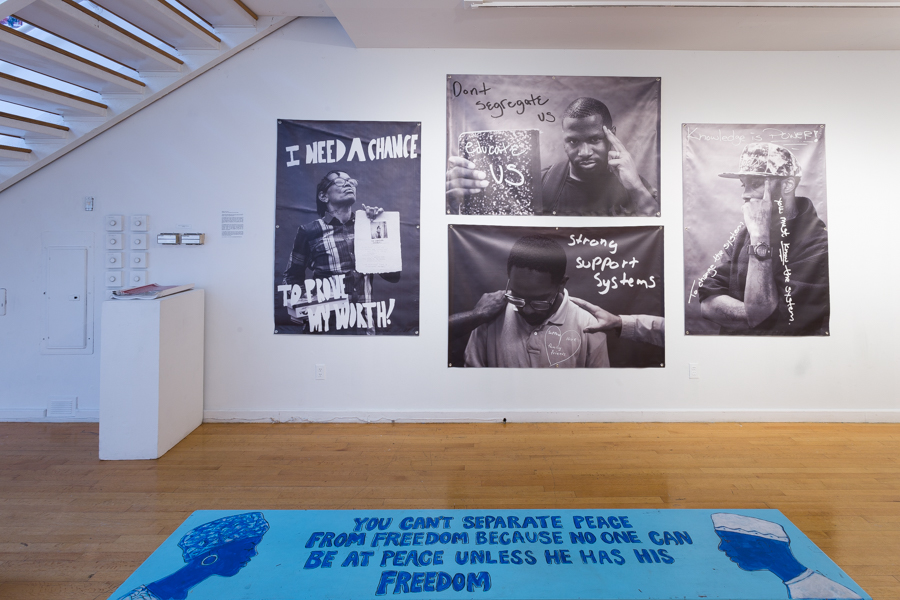Changing the System with Alabama Prison Arts (Part 2)
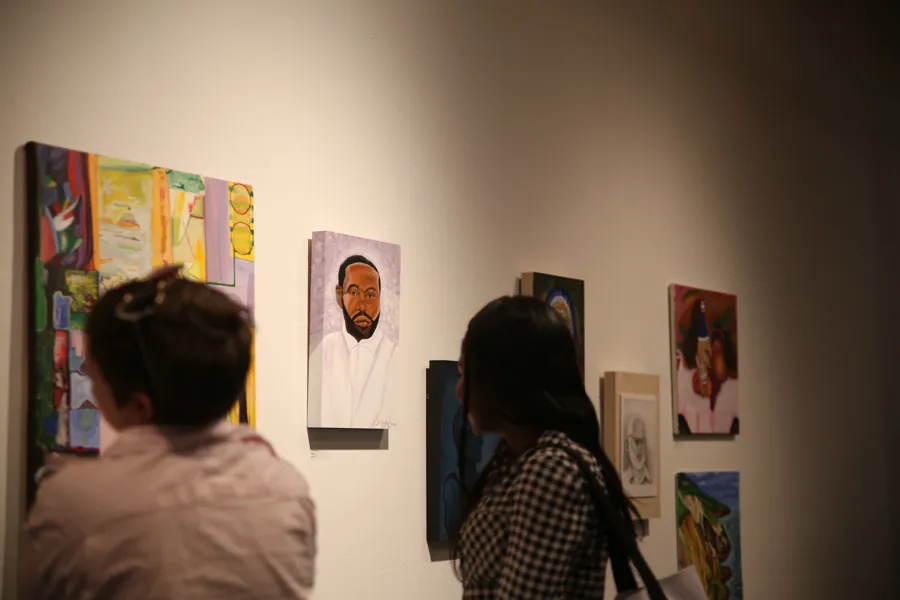
Last week, we shared Part 1 of a conversation between Robyn Buseman, our Restorative Justice program director, and Kyes Stevens, founder and director of the Alabama Prison Arts + Education Project. Read Part 1 here, and come back for Part 2, where Robyn and Kyes get into funding, relationship-building, and the basic human value of everyone who is incarcerated.
What are some of your program’s current struggles?
Robyn: We have women in the Guild program—three out of nine, which about matches the percentage of women that are incarcerated, about 10–20 percent. We have women in the YVRP Guild, one or two out of 10 or 15. But the state women’s prison in Pennsylvania is out about six hours away from here, so we can’t provide any programming. It’s in the middle of the state. A new transitional unit is opening up near Graterford, closer to home, so we’re looking forward to working with those women.
Kyes: Is there any possibility of trying to find a partner in the state who could help y’all implement your programming? Six hours is a long way away.
Robyn: Well, the other problem is funding. The state doesn’t give us funding, so we have to raise all the money through private funders, and it would be pretty tough for us to monitor and provide reports on something so far away. We do have a women’s county jail and we did a mural inside—we actually used to have a lot of programming inside, but they cut back on our budget, too, so now the women are just part of the Guild. That’s all we have to offer them—jobs—which is good, but they’re on work-release, so they go back to the prison at night. We work closely with that unit, and it is a specialized population. I wish we did more specialized programming.
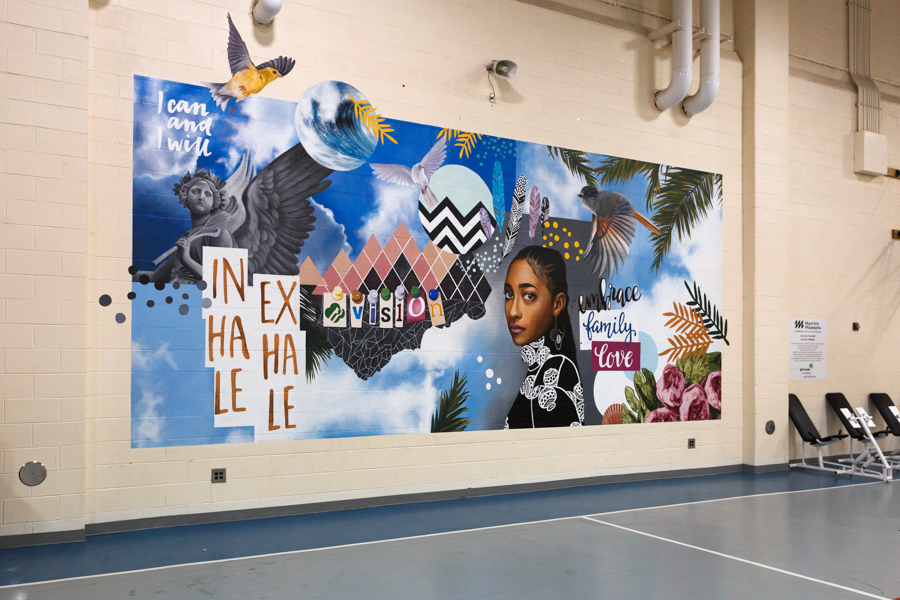
Kyes: A lot of what we do is based on who we’re able to get funding from in any given year. So we’ve had a funding agency in the past that allowed us to do some murals inside of the correctional facilities, and in two of the facilities, we focused on trying to make the family visitation spaces look nicer, because they were dismal at best. But again, you have to find a funder that will support that specific project. And you guys know, organizing things with the Department of Corrections takes time, and quite a lot of patience. You have to find things that will work within their highly regimented schedule, and with the availability of our teaching artists or teaching writers. What we’ve tried to do is maintain programming with every facility we work in. There have been a couple of exceptions to that as of late, because the Alabama DOC is so incredibly under-staffed, with their security personnel, so we become a burden. Sometimes they can find a place for us to be and there is security present, but we’re the outsiders. They want to make sure that we’re safe and that everything is well. So we’ve got a little bit of a hold on a couple of facilities right now until things get smoothed out. The programs started with poetry, and then we moved to visual arts and the humanities, and then it grew to STEM programming, and now we’re doing a college degree. Our basis is the arts and humanities, but what we do with all of our facilities is to rotate. So if we do a visual arts class at Tutwiler [Prison for Women] one semester, then maybe the next semester we’d do a science class or a literature class, and then we’d rotate back. Because the women have so many varied interests—and it’s the same thing with the men. So we just try to have variety inside of the facility.
I feel like we as a society spend a lot of time trying to find a silver bullet, the one thing to fix a problem. And it doesn’t work that way. We need to change our mindset to understand that to give people opportunities and make changes in communities takes a lot of people power. And it takes funding to do that. You have to invest in the solution on the individual level and on the long-term level. You don’t have to answer this question, but maybe I’ll just pose it and we’ll leave it unanswered: how many arts agencies are there that you know that give four or five-year grants that say, here, we would like to invest in this and we believe in what you’re doing, and send us reports? They don’t do that. So you spend a colossal amount of your time writing grants and trying to figure out how you’re going to keep your programming together, when honestly you’re probably better used at the programmatic level. That’s what most of us would rather be doing.
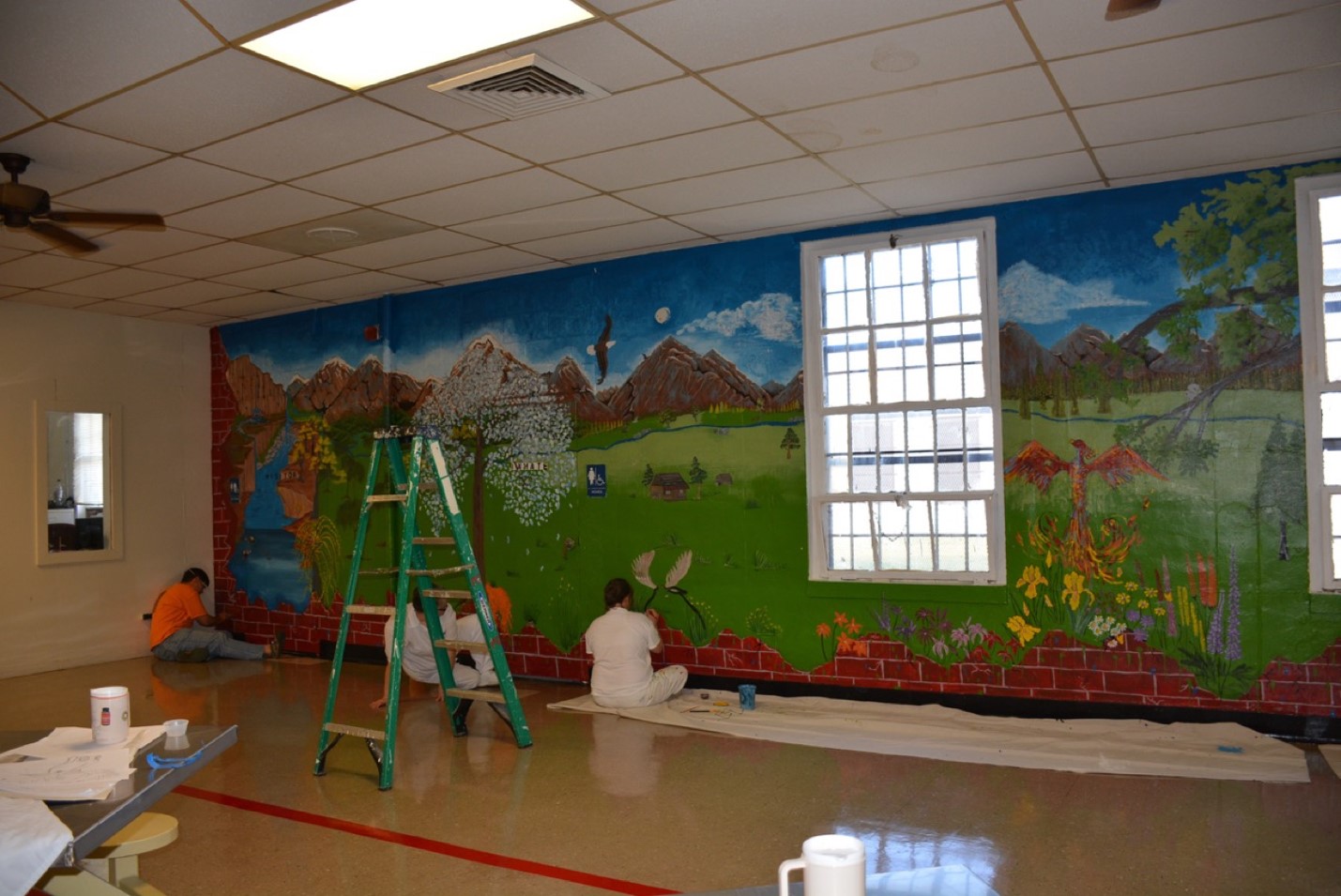
Can you talk about balancing the various types of relationships that go into doing this work?
Kyes: Everybody who works inside of a prison, you’ll discover, in ways you didn’t understand before you stepped inside of a facility: all the multiple levels of human-ness, and all the things that influence human lives, and that most of our students didn’t have very easy lives, and suffered quite a lot as young people and as children. That influences how we evolve as people. I wish we could cultivate some compassion for that.
Robyn: That little bit of empathy goes a long way. I find it interesting that you’re working in Alabama, as one of the most highly-incarcerated states. What different relationship challenges do you have there that we might not have here?
Kyes: You know, it’s interesting. I’ve actually been into Graterford, into facilities in New York, and Illinois, and Missouri, and California. I’ve been into a lot of facilities, and the prison system in Alabama is an incredibly broken system for everyone. For the people who live there, and the people who work there. We, for the most part, have had nothing but incredibly supportive wardens. We work in 10 prisons, and we have wardens call us and ask for programming. So we don’t, in a lot of ways, face some of the hurdles that colleagues around the country face—we have a model and a template with our classes that works—our classes are 14 weeks long, and they meet once a week, and they meet on this day for two and a half hours, and they allow the system to function fairly smoothly, and without creating an exceptional amount of extra work for the facility.
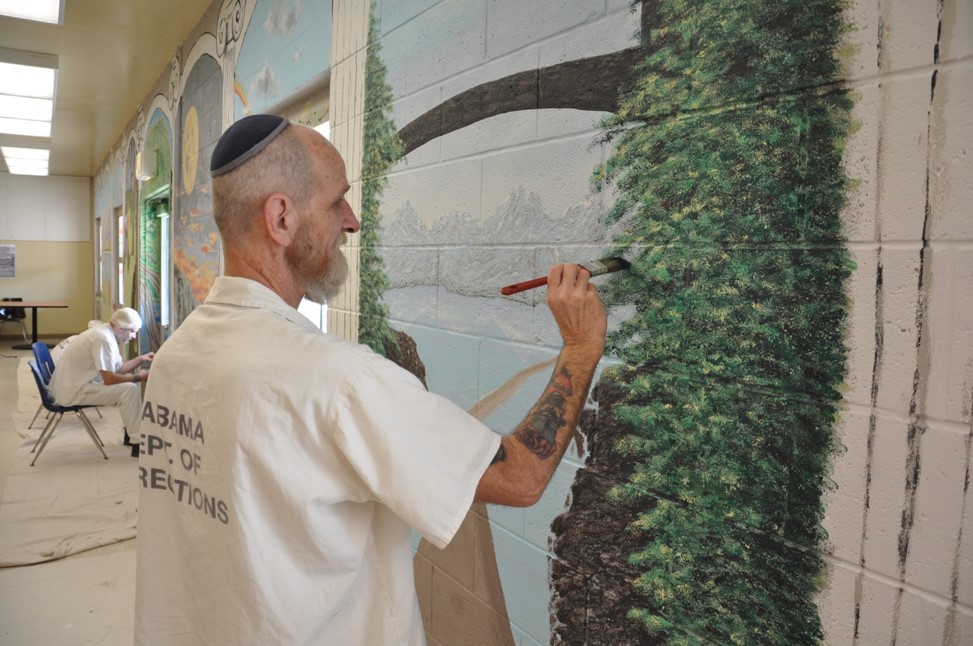
This is going to sound like complete common sense, but I think sometimes all human beings let their common sense fly out the window: if you want to get things done, you need to build relationships with people and you need to listen. I listened to the DOC when I first started coming into the facilities, and it helped me a lot because it helped me understand what their hurdles are. And it helped me design something that would not create unnecessary hurdles for them. You know, it’s a super conservative state, where sometimes for incarceration per capita we’re number one, sometimes we’re number three—but we’re always leading in that unfortunate category. And we’re trying to change it, but it’s a “get tough on crime” state. Our university is a land grant institution, and land grant institutions exist to do education on campus, research, and outreach, so we see this as an extension of outreach. We are going into communities in the state and being part of the university, I think, helps our program a lot. There are not too many nonprofits in the state that work inside of the facilities, so nothing’s easy down here. I think maybe I have an easier time with it because I’m from here.
Robyn: You’re absolutely right about those relationships, and the structure that you provide, and that they trust you. Trust is so important in this work. You have to be mindful, and security is important.
Kyes: We just try to be smart, and we’ve never had any kind of security issue with our programming. At this point, we’re pretty well over offering 200 semester-length classes in 10–12 prisons around the state, and it works well. So we’re going to keep trying to do the things that we know are good. I have great respect and wonder, and I’m very envious of how you all are able to get the community support that you get. Because I don’t know that we have that—and maybe it’s because you’re in an urban, metropolitan area, and it’s easier to cultivate a community—but I have always been like, “Wow, they have all these different organizations and entities working with the program,” which I think is remarkable.
Robyn: We’re pretty fortunate, because those same relationships you were talking about were built here, with the DOC and the County Prison. Philadelphia is a city and a county, and Mural Arts is partially a city agency, so we do get support from the city. We’re really fortunate that we can talk about these issues. When we go into communities, sometimes we get pushback, but often we get support because we’re doing something for the community, like a mural or a garden project. It really facilitates developing the idea that someone on probation can help build a better community. And Philadelphia is a liberal town, so we do benefit from that, although the surrounding counties are not liberal. They’re quite conservative, so we work mostly in the city. The State Secretary of the DOC, John Wetzel, is very much into alternative methods and is very supportive. We’ve had the same experience with our wardens that you’ve had, and the commissioner, and the mayor—we’re just lucky. We just try to do what we say we’re going to do.

What is happening in the field that you’d like to emulate?
Kyes: I just got back last night from the National Alliance for Prison Higher Education Conference, and the conference made an unbelievable effort this year to provide scholarships, which allowed more formerly incarcerated students to attend—because getting to a conference is a fiscal hurdle for a lot of people. They have the Formerly Incarcerated Students Network, which is this beautiful tool that the former students have created, to help be a support mechanism for each other, and a resource. I keep thinking about how that model could be a great service model inside of a state, so that maybe when you’ve got a town of 5,000 people but you’ve got people who are interested in being mentors, that information could be available [online].
Robyn: Yeah, that would be fantastic. We keep trying that in the arts—California has been kind of pushing us. I’m glad that you went to that conference. There’s a big push now to have more college classes inside, so I’m glad that people are getting together and talking about that.
Kyes: This was the seventh year of the conference. I think the first year we had it at the University of Illinois—I don’t think there were more than 75 or 80 people there, but that was the foundation. I think we had about 320 folks this year. You guys know this just like I do, and everybody else who does this kind of work: in some capacities, we exist in silos because the vast majority of the general public doesn’t have any clue that our types of programs exist—or doesn’t even value our types of programs.
Robyn: Exactly. I think the pendulum is swinging, though. “Oh, why do they have an art program in prison? Why do they have college in prison? Why do those guys get to go to college and my kids can’t go to college?” These people are coming out [of prison], and do you want them to come out more educated, more humanized, or do you want them to come out with nothing? So I’m hopeful that we’ll have more programming inside. Plus, it costs so much money to keep people incarcerated, and the recidivism rates are so high.
My favorite program that I visited out in LA is Homeboy Industries. They have this all-encompassing center for people going through reentry. It’s got counselors, it’s got a restaurant where they can learn about the restaurant business, silk-screening, they have their own farm. It’s run by a Jesuit priest, and he’s phenomenal. They have tattoo removal, doctors that volunteer. When I was there, there was a doctor just walking around, asking, “You want any tattoos you want off?” It’s real warm—they start the day with a welcoming circle. You start by working and showing up, gradually getting a job. It’s a nice one-stop-shop service for people, and they have their own restaurant at the airport now, a Homeboy gift shop and Homegirl Café. It’s a phenomenal model, and I thought it was very supportive. It’s centered around East LA and the Chicano community. It’s grassroots, organic, and it’s local. Those kind of models, I think, are pretty powerful.
Kyes: There are so many incredible programs, and each of them have things that make them distinctive. You always look and think, “That’s fantastic! What a great idea!” When I think about the world of prison higher education, there’s a program out of Saint Louis University that, when they started their degree-granting program for incarcerated students, simultaneously started a program for officers and staff. So the opportunity was created for both, and there are a lot of people that would actually love to do that, but there are all these fiscal limitations that make it hard for people to do what they would like to do. It’s money.
You said something earlier, Robyn, about people who say, “Why is this person getting to learn how to write poetry?” or “Why are they learning how to paint, because I can’t afford that for my child,” or “Why are we paying for this person to get a degree?” I wish we lived in a culture and a society where it was not set up as an either/or. If somebody wants to go to college, they should be able to go to college, and art needs to be in every K–12 institution in the country.

I think it’s fairly unreasonable to ask any human being, whether they are incarcerated or not, to make significant individual, personal changes without support mechanisms. We ask so much of people who are coming out, to be able to step back into a changing world—there’s not a lot there [for them]. We have a student who was recently released, who’s probably taken at least 20 semester-long classes from us, and he paints, and he sent me an email the other day with the first painting he’s done since he’s been released. It’s only been a few months, and there’s this overwhelming joy and pride and comfort that he has that, while he’s trying to rebuild his life and figure out how to be, he also has his creative voice. The value of that, for any human being, is pretty much—I don’t think you can put a value on it.

